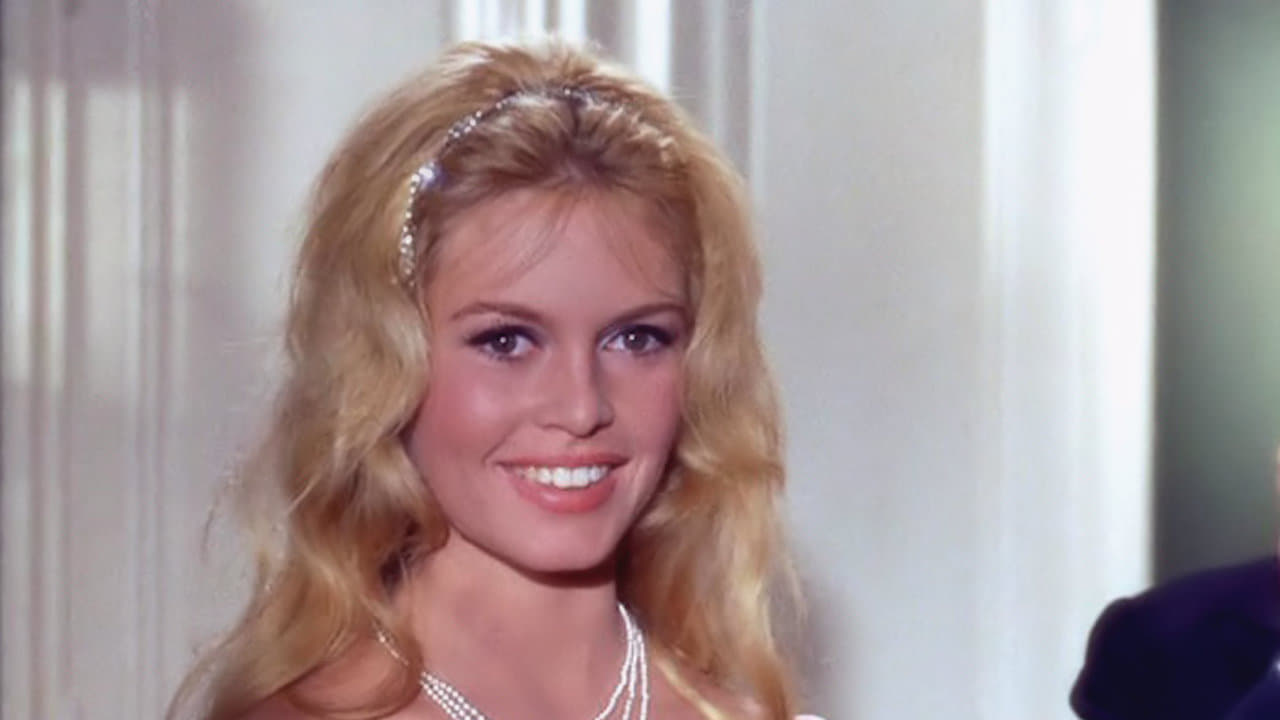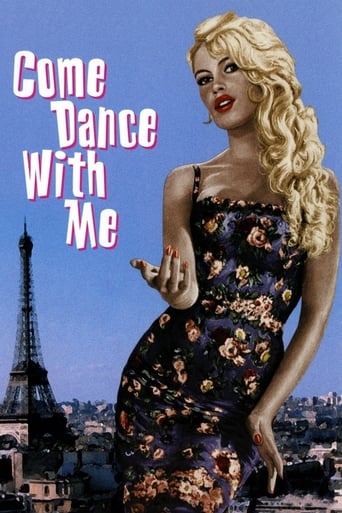

Come Dance with Me is an odd film, more reminiscent of one of Alfred Hitchcock's lighter moments, in particular, his collaborations with Cary Grant. The character of her husband, though, does little to solve the mystery, making him an anti-Cary Grant as his wife, played by Bardot is the key figure in solving the mystery.Of course the point, towards the end, when the film deals openly with a dark and sordid homosexual subculture differentiates it from the English and American cinema of the day which would never have tackled such a topic so openly.(On that note, it is worth mentioning that the film may sit uncomfortably with those viewers in favour of homosexual rights today as the subculture is shown to be depraved and, ultimately, murderous. Those not in favour of homosexual rights will find that it shows the seedy world of the gays in a direct, unsanitised fashion that stands in contrast to the current climate of political correctness.) The acting throughout the film is stiff and it is unclear at times whether this was meant to be a comedy or a light drama. One is disappointed that the potential for a locked-room mystery is quickly dismissed only to be delighted as more twists are introduced showing that the case is more complex than it first appears.(As an aside, on the topic of locked room mysteries, Bardot makes some delightful references to France's most famous fictional novel of that type, Leroux's Mystery of the Yellow Room.) Of course, there is little character development in a film of this type and the acting is never particularly strong but there is a breezy feel and the performances are competent. Most notable is a cameo by a young Serge Gainsbourg as a sinister blackmail co-conspirator.There is little in the way of adventurous cinematography but the setting of Bardot's house would have seemed strikingly modern at the time and the use of light colour helps, once again, emphasise the bright mood of this piece.In contrast, the homosexual club is shown to be a dark, seedy place and Bardot stands out as a radiant figure surrounded by the depraved clientèle.The use of flashback to reconstruct the murder at the end is a solid, if timeworn technique.Some aspects of the plot's construction make little sense, however. The fact that the husband is a dentist never seems particularly significant, nor does the dance hall setting. A slightly tighter structure and more emphasis on the symbolic would have lifted this film's rating quite significantly.In conclusion, this is a straightforward film with a light-hearted feel that takes a sudden dark turn towards the end. The murder mystery is quite clever and deals with a sordid underworld rarely depicted in film at that time. The abrupt change of tone is somewhat problematic, though. Bardot is the key figure as she adopts the role of an amateur detective and though it may not be a role best suited to her, she does a credible job. There are enough plot turns after the initial expectation of a locked-room mystery is dismissed to keep the film interesting and there is a strong late-1950s French atmosphere invoked throughout. Recommended.
... View MoreThis and another early Brigitte Bardot vehicle, UNE PARISIENNE (1957), had been available for rental at a local DVD store for a long time but I kept postponing getting to either, believing them to be minor frothy affairs; however, having just acquired and being on the point of watching a similar effort of hers – Marc Allegret's MADEMOISELLE STRIPTEASE aka PLUCKING THE DAISY (1956) – I thought I might as well check them out too while I am at it. Anyway, I opted to start with this one being ostensibly a thriller and, while I was expecting it to involve some nudity from the star (which technically there is none), I was surprised – especially when considering the film's essentially light touch – at the amount of sleaze on display (from explicit situations and dialogue to a subplot involving gay bars and drag queens!). The premise, in fact, revolves around the Police investigation into the murder of blackmailing dance teacher Dawn Addams; incidentally, the Inspector on the trail of the assassin is Luis Bunuel regular Paul Frankeur and Serge Gainsbourg, popular yet controversial singer/songwriter and later film-maker, makes an early appearance as the victim's accomplice (photographing her in compromising positions with wealthy patrons). Their latest victim is dentist Henri Vidal (whose last film this proved to be, expiring from a heart attack at the young age of 40 – he was married to star Michele Morgan, having met on the set of his best-remembered movie i.e. the Italian spectacle FABIOLA [1948]); Bardot is his wife, whose father (Noel Roquevert, from a number of H.G. Clouzot titles) is an industrialist. Vidal had run into Addams at a nightclub after a row with his bride: she even goes to his clinic, where Bardot works as his assistant, and supplies him with incriminating photos of their dalliance. On his part, not intending to pay, he visits Addams at her studio and causes a scene – but then relents and makes an appointment for the next day at the same place; when he arrives, Vidal finds the woman dead and is then surprised in the room by Bardot who had followed him there! Of course, he has to confess everything and though Roquevert does not readily believe him, Bardot does and determines to establish his innocence (since his description was given to the Police by Addams' dance colleagues) by finding the real killer. To this end, she takes a job as a dance teacher there and even ingratiates herself with Frankeur; incidentally, it appears that the killer could not have exited the room before Vidal's entrance as there is no other way out: this actually reminds Bardot of the Gaston Leroux novel "The Mystery Of The Yellow Room" (whose 1930 film adaptation by Marcel L'Herbier, along with its sequel THE PERFUME OF THE LADY IN BLACK – nothing whatsoever to do with the atypical Italian giallo from 1974 – I have also just gotten my hands on!) and from here on in, as the saying goes, the plot thickens. Despite the generic and downright misleading title, this is a fairly enjoyable picture (especially easy to take in pleasant color); mind you, the suspense reaches no great heights (given that the murder method is given away all too soon and the motive emerges to be characteristically weak) – and, yet, the viewer's attention is engaged throughout and one is genuinely curious to discover the guilty party's identity (what with the variety of suspects being fingered along the way).
... View MoreI just want to take note of the great Serge's Gainsbourg stunning appearance, short but classic! "L'homme a la-Tete-De-choux" enters with class, sets his line, and the rest is history...Check out Gainsbourg the artist: jazzman, musician, singer, poet, provocateur, precursor of rap, pop idol, eighties cult, through his musical career. Not to mention Brigitte Bardot in all of her splendor, a must see for any BB fan (check out the song "Bonnie and Clyde" for another Bardot/Gainsbourg collaboration). Good stay-at-home and somewhat suspenseful movie. Worth watching. I found this movie very enjoyable, definitely not a classic, but reminiscent of the pre-60's French thrillers.
... View MoreThis well-made movie just has one flaw: Brigitte Bardot is not suited for playing a crime plot. As her talents are with light comedy, she is not able to carry out the necessary mystery, horror and suspense here.For this reason I think 'Voulez-vous danser avec moi?' not entirely convincing. But apart from that, it's quite entertaining. It is shot well, its acting is good, and its story catches the viewer's interest from beginning to end. Of course your special attention for the scenes in the dance-school, fully displaying Brigitte's excellent dancing skills.This movie also seriously deals with homosexuality, back in 1959 a groundbreaking issue. For this reason I guess Paris must have been the only location possible.
... View More